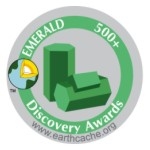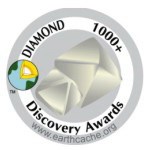Elberton Georgia's Granite Earthcache EarthCache
Elberton Georgia's Granite Earthcache
-
Difficulty:
-

-
Terrain:
-

Size:  (not chosen)
(not chosen)
Please note Use of geocaching.com services is subject to the terms and conditions
in our disclaimer.


NOTE: The hours of the museum are Monday thru Saturday, 2 PM to 5 PM.
From Egypt’s pyramids to the Panama Canal, granite has been one of mankind’s first choices for creating enduring legacies in stone. Granite is one of the most abundant rocks in the earth’s crust, making it easy to find---but quarrying and working granite has never been easy.
Granite is exceptionally hard, durable, and resistant to the elements. For these reasons, and for granite’s natural beauty, it has long been regarded as a material that is worth the hard work required to quarry and finish it.
The Elberton Georgia quarries discard 60 percent of the granite it recovers from the quarry due to imperfections in the stone while "Rock of Ages" quarry in Vermont discards 85 percent of the granite it recovers. The scrap ends up in tremendous grout piles - Scottish for "waste".
Granite rocks are igneous rocks formed by slowly cooling pockets of magma trapped beneath the earth's surface. Igneous rocks form from molten rock which is either ejected at the surface of the earth or cools underground. Igneous rocks make up 95% of the rocks of the earth's crust. They are also some of the oldest rocks found at the surface of the earth. Igneous rocks are classed on the basis of where they form and the composition of the molten rock. Magma originates from the melting of the earth's crust and upper mantle. This melting occurs about a depth of 60 to 200 km. As pockets of magma cool slowly underground, the magma becomes an igneous rock. This molten rock is less dense than the solid rock, so it rises towards the surface. Molten rock that cools before it reaches the surface hardens to become intrusive igneous rock. Because it forms deep beneath the earth's surface, it has more time to cool and develops large crystals. Intrusive rocks include granite.
The minerals which make up granite are composed of silicon and oxygen. Granite is made out of big crystals; you can easily see them with the naked eye. This is because the granite cooled slowly underground, shielded by the rock surrounding it so that its great heat could escape slowly. Granite is made out of feldspar and quartz, plus minor amounts of other minerals. Feldspar and quartz are light minerals. Therefore, when hot molten rock is coming up from the mantle, some minerals grow crystals and then later, others form. If the magma (liquid rock) keeps moving, those early crystals are left behind, until finally what are left are mostly the ingredients for feldspar and quartz. The result: granite.
Mineralogically the granite here is similar to other granites, except the Elberton granite composition is such that it weathers extremely well, its color does not fade and it absorbs only 0.23% water.
Geologists have estimated that the granite beneath Elberton is a single deposit approximately 35 miles long, six miles wide, and between two and three miles deep. This abundant resource will be available well into the future. It is estimated that Georgia's famous Stone Mountain is a separate deposit and is less than one percent the total size of the Elberton deposit.
To log this cache you must email us the following information/answers and submit a photo:
1. How much of the total United States granite production is produced in the Elberton area?
A. 10%
B. 25%
C. 33 1/3%
D. 50%
2. Granite is composed of....
A. Limestone, Silica, and Iron-oxide
B. Feldspar, Quartz, and Biotite
C. Quartz, Alumina, and Gneiss
3. What color is Elberton Granite?
A. Blue-Gray
B. Light Gray
C. Charcoal
Also upload a photo with your find log of you or your group with your GPSr at the above listed coordinates with the museum sign in the background.
Each cacher is required to send the required information and not rely on another cacher to provide it. Failure to follow this procedure will result in a deleted log. It is not my job to keep track of your group.
I request that you email your answers to me on the same day that you log your “found it” log. (This does not have to be the day you visit, just the day you log the find on the computer.) I also request that you do not log a “found it” log unless you have actually visited the site of the earthcache and sent the answers to me. The only person who really benefits from your visit is YOU.
XXXXXXXXXXXXXXXXXXXXXXXXXXXXXXXXXXXXXXXXXXXXXXXXXXXXXXXXXXXXXXXXXXXXXXXXXXXXXXXX
We became Platinum Earthcache Masters on September 17, 2007.
We were the first to request and receive on July 2, 2011 the Emerald Discovery Award for finding 500 or more Earthcaches.
We received the Diamond Discovery Award on June 17, 2012 for finding 1,000 or more Earthcaches.



XXXXXXXXXXXXXXXXXXXXXXXXXXXXXXXXXXXXXXXXXXXXXXXXXXXXXXXXXXXXXXXXXXXXXXXXXXXXXXX

Additional Hints
(No hints available.)